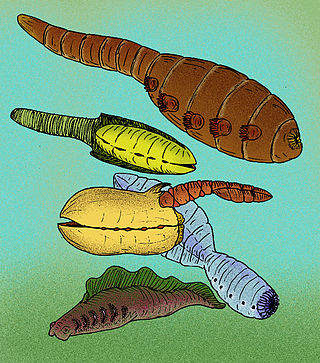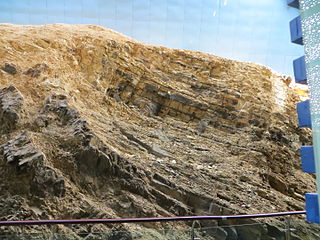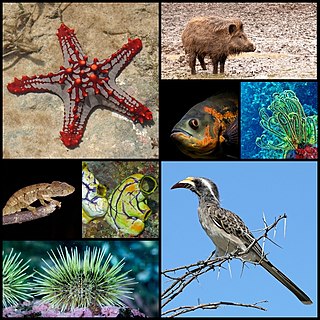
Lobopodians are members of the informal group Lobopodia, or the formally erected phylum Lobopoda Cavalier-Smith (1998). They are panarthropods with stubby legs called lobopods, a term which may also be used as a common name of this group as well. While the definition of lobopodians may differ between literatures, it usually refers to a group of soft-bodied, marine worm-like fossil panarthropods such as Aysheaia and Hallucigenia.

Vetulicolia is a phylum of bilaterian animals encompassing several extinct species belonging to the Cambrian period. The phylum was created by Degan Shu and his research team in 2001, and named after Vetulicola cuneata, the first species of the phylum described in 1987.

The Maotianshan Shales (帽天山页岩) are a series of Early Cambrian sedimentary deposits in the Chiungchussu Formation, famous for their Konservat Lagerstätten, deposits known for the exceptional preservation of fossilized organisms or traces. The Maotianshan Shales form one of some forty Cambrian fossil locations worldwide exhibiting exquisite preservation of rarely preserved, non-mineralized soft tissue, comparable to the fossils of the Burgess Shale of British Columbia, Canada. They take their name from Maotianshan Hill in Chengjiang County, Yunnan Province, China.

Deuterostomes are bilaterian animals of the superphylum Deuterostomia, typically characterized by their anus forming before the mouth during embryonic development. Deuterostomia is further divided into 4 phyla: Chordata, Echinodermata, Hemichordata, and the extinct Vetulicolia known from Cambrian fossils. The extinct clade Cambroernida is also thought to be a member of Deuterostomia.

Miraluolishania is an extinct lobopodian known from Chengjiang County in China. It is remarkable for the possession of lensed pit-eyes. The only species, Miraluolishania haikouensis, was described from the Maotianshan Shales at Haikou by Jianni Liu and Degan Shu in 2004. In 2009, a team of palaeontologists at the Yunnan University, led by Xiaoya Ma reported the discovery of 42 other specimens from Haikou. With the help of Swiss palaeontologist Jan Bergström, Ma and Hou came to the conclusion that all the specimens were the same species as Luolishania; another lobopod discovered from the Chengjian in 1989. Chengjian is 40 kms from Haikou and the fossil fauna are different. A reassessment by Liu and Shu's team at the Northwest University in 2008 established that Luolishania and Miraluolishania are distinct animals.

The palaeoscolecids are a group of extinct ecdysozoan worms resembling armoured priapulids. They are known from the Lower Cambrian to the lower Ludfordian ; they are mainly found as disarticulated sclerites, but are also preserved in many of the Cambrian lagerstätten. They take their name from the typifying genus Palaeoscolex. Other genera include Cricocosmia from the Lower Cambrian Chengjiang biota. Their taxonomic affinities within Ecdysozoa have been the subject of debate.

Stromatoveris psygmoglena is a genus of basal petalonam from the Chengjiang deposits of Yunnan that was originally aligned with the fossil Charnia from the Ediacara biota. However, such an affinity is developmentally implausible and S. psygmoglena is now thought to be either a sessile basal ctenophore, or a sessile organism closely related to ctenophores. Nevertheless, a 2018 phylogenetic analysis by Jennifer Hoyal Cuthill and Jian Han indicated that Stromatoveris was a member of Animalia and closely related to ediacaran frond-like lifeforms.

Diania is an extinct genus of lobopodian panarthropod found in the Lower Cambrian Maotianshan shale of China, represented by a single species - D. cactiformis. Known during its investigation by the nickname "walking cactus", this organism belongs to a group known as the armoured lobopodians, and has a simple worm-like body with robust, spiny legs. Initially, the legs were thought to have a jointed exoskeleton and Diania was suggested to be evolutionarily close to early arthropods, but many later studies have rejected this interpretation.
Stage 2 of the Cambrian is the unnamed upper stage of the Terreneuvian Series. It lies atop the Fortunian and below Stage 3 of the Cambrian. It is commonly referred to as the Tommotian, after the Cambrian stratigraphy of Siberia. Neither the upper nor lower boundary has yet been defined by the International Commission on Stratigraphy. The preferred definitions for the lower boundary are the first appearance of the molluscs Watsonella crosbyi or Aldanella attleborensis around 529 million years ago. The correlation between the lowest occurrences of A. attleborensis and W. crosbyi with the Zhujiaqing positive carbon isotope excursion (ZHUCE) has led to the conclusion that the combination of these two markers are a reliable indicator of the boundary between the Fortunian and Stage 2. The proposed upper boundary might be the first appearance of trilobites around 521 million years ago.
Xianguangia is a soft-bodied sea anemone-like fossil animal from the Chengjiang Biota of China.

Antennacanthopodia is a rare unarmoured lobopodian from the Chengjiang biota, with prickly legs, a pair of 'antennae', and an onychophoran-like body outline. It also has a pair of frontal antennae, potential ocellus-like lateral visual organs, second antennae possibly homologous to the slime papillae of modern Onychophorans, a straight, voluminous midgut, diminutive spines arrayed on the leg and the trunk, well-developed leg musculature, highly sclerotized terminal leg pads, and presumptively a pair of posteriormost appendicules.

Vetulicola rectangulata is a species of extinct animal from the Early Cambrian of the Chengjiang biota of China. Regarded as a deuterostome, it has characteristic rectangular anterior body on which the posterior tail region is attached. It was described by Luo Huilin and Hu Shi-xue in 1999.
The Yanjiahe Formation is an Ediacaran to Cambrian fossiliferous geologic formation found in South China.

Scleroctenophora is an extinct class of stem group ctenophores, known from the Chinese Maotianshan shales of Yunnan. It is dated to Cambrian Stage 3 and belongs to late Early Cambrian strata. Scleroctenophorans are easily distinguished from other ctenophores by the presence of an internal skeleton that supports the body.

Saccorhytus is an extinct genus of animal possibly belonging to the superphylum Ecdysozoa, and it is represented by a single species, Saccorhytus coronarius. The organism lived approximately 540 million years ago in the beginning of the Cambrian period. Initially proposed as a deuterostome, which would make it the oldest known species of this superphylum, it has since been determined to belong to a protostome group called the ecdysozoans.

Onychodictyon is a genus of extinct lobopodian known from the Lower Cambrian Chengjiang Maotianshan Shales in the Yunnan Province in China. It was characterized by a stout body covered by fleshy papillae and pairs of sclerotized plates with spines, representing part of the diverse "armoured lobopodians" alongside similar forms such as Microdictyon and Hallucigenia.

Hymenocarina is an order of extinct arthropods known from the Cambrian. They possess bivalved carapaces, typically with exposed posteriors. Members of the group are morphologically diverse and had a variety of ecologies, including as filter feeders and as predators. Recent research has generally considered them to be stem or crown group members of Mandibulata, due to the presence of mandibles in some species.

Vetulocystidae is the only family of the taxon Vetulocystida, which is a group of extinct deuterostomes of uncertain phylogenetic position. Vetulocystidae is made up of the genera Vetulocystis, Dianchicystis and Thylacocercus.
Luolishania is an extinct genus of lobopodian panarthropod and known from the Lower Cambrian Chiungchussu Formation of the Chengjiang County, Yunnan Province, China. A monotypic genus, it contains one species Luolishania longicruris. It was discovered and described by Hou Xian-Guang and Chen Jun-Yuan in 1989. It is one of the superarmoured Cambrian lobopodians suspected to be either an intermediate form in the origin of velvet worms (Onychophora) or basal to at least Tardigrada and Arthropoda. It is the basis of the family name Luolishaniidae, which also include other related lobopods such as Acinocricus, Collinsium, Facivermis, and Ovatiovermis. Along with Microdictyon, it is the first lobopodian fossil discovered from China.

Lenisambulatrix is a genus of extinct worm belonging to the group Lobopodia and known from the Lower Cambrian Maotianshan shale of China. It is represented by a single species L. humboldti. The incomplete fossil was discovered and described by Qiang Ou and Georg Mayer in 2018. Due to its missing parts, its relationship with other lobopodians is not clear. It shares many structural features with another Cambrian lobopodian Diania cactiformis, a fossil of which was found alongside it.
















